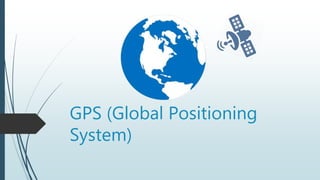
Gps (global positioning system)
- 2. Presented by: 873- Mustahsan Khan - Akbar Shahis Abdul Wahab Mohsin Bin waqar Sohail Ahmad
- 3. What is GPS ? GPS or Global Positioning System is a network of orbiting satellites that send precise details of their position in space back to earth. The signals are obtained by GPS receivers, such as navigation devices and are used to calculate the
- 4. When & Why it was Developed ? The very first GPS system was developed in the 1960s to allow ships in the US Navy to navigate the oceans more accurately. The first system had five satellites and allowed ships to check their location once every hour. GPS is well-known for its military uses and was first
- 5. Segmentations of GPS The Space Segment The Control Segment The User Segment
- 6. The Space Segment Consists of 24 satellites in 6 orbits. a constellation of between 24 and 32 solar-powered satellites orbiting the earth in orbits at an altitude of approximately 20000 kilometers, Each satellites transmits low
- 7. The Control Segment : A Master Control Station Unmanned Monitor Stations Large Ground- antenna Stations
- 8. The User Segment : Users-Military and Civilians GPS Receivers Decodes the signals from Satellites. Calculate the distance.
- 9. What signal does GPS use : There are currently between 27 and 32 global positions system (GPS) satellites in orbit around the earth. Of these, three act as backups. Each satellite transmits a regular GPS signal that is carried by radio waves in the microwave part of the electromagnetic spectrum. microwave carrier frequency of approx 1600 MHz
- 10. How does GPS work? Each of the satellites is in an orbit that allows a receiver to detect at least four of the operational satellites. The satellites send out microwave signals to a receiver where the built-in computer uses these signals to work out your precise distance from each of the four satellites and then triangulates your exact position on the planet to the nearest few meters based on these distances.
- 11. What is Trilateration? A GPS receiver uses trilateration (a more complex version of triangulation) to determine its position on the surface of the earth by timing signals from three satellites in the Global Positioning System. The GPS is a network of satellites that orbit the earth and send a signal to GPS receivers providing precise details of the receiver's location, the time of day, and the speed the device is moving in relation to the three satellites.
- 12. Determination of Position: By Triangalization. Triangulation is the mathematical principle that explains how GPS works. There are two types of triangulation: 2-D and 3-D. GPS uses 3-D triangulation. 3-D has the capability to tell altitude or height, while 2-D doesn’t have that capability.
- 13. Calculation & Determination of a position : For determining the positions , Some relations are there : we let Delta ti = Ti' - Ti, X Y Z are the axis epsilon represent any error in our clock's time.
- 14. Calculation of Position : Satellites Location Almanac data The GPS Almanac is a set of data to describe the orbits of the complete active fleet of Satellites. GPS receivers use the almanac to determine "approximately" where the satellites are relative to the local sky. It then uses this information to determine what satellites it should track. Time is the essence Velocity * Time=distance
- 15. Sources of Error : Ionosphere Delays Troposphere Delays Clock Error Multi-path Error Relativity Error
- 16. Applications and Industry Agriculture Mapping & GIS Data Collection Public safety Surveying Telecommunication